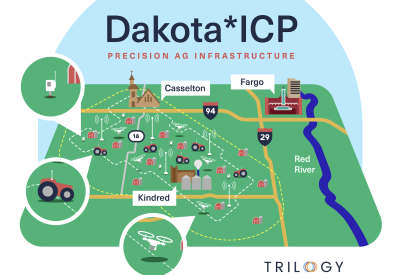Trilogy Networks and the North Dakota broadband provider MLGC have won a deal with 25 North Dakota farms to provide telecommunications infrastructure and precision agriculture software that will enable data-driven farming through the use of fiber networks, 5G wireless, cloud computing and IoT sensors.
The 25 farms encompass 250 square miles, exceeding 150,000 acres.
According to George Woodward, president and CEO of Trilogy Networks, the multi-million-dollar Dakota Innovation Corridor Project is “The world’s largest deployment of precision agricultural infrastructure to enable data-driven farming.”
While the telecommunications industry is excited about its prospects for providing private wireless networks for such large operations as factories, utilities, airports and the like, Woodward says those opportunities pale in comparison to the chance to provide connections across 915 million acres of tilled land in the U.S.
And he said low-tech technology, such as providing moisture sensors for farmers, could help them save a lot of money and time as well as increase food production. For example, if a farmer owns non contiguous land spread across many miles, the moisture levels will vary in different locales, and without sensors he either must guess where to water or physically drive out to a field and check. “The lowest tech has got them all excited,” said Woodward.
The telecom infrastructure
Trilogy partners with internet service providers to create a network called Linx, and then it layers its compute and storage on top of that network at edge locations to provide connectivity for precision agriculture uses.
For the Dakota Innovation Corridor Project, the infrastructure is supported by MLGC’s fiber optic network. Family-owned MLGC operates in a few counties in North Dakota where Trilogy will be providing its services.
MLGC is also a partial owner of the North Dakota State Network, which claims to have about 90% broadband penetration to farms and residences across the state. Woodward said Trilogy anticipates that in time it will leverage the North Dakota State Network, in addition to MLGC’s network.
“There’s a lot of things that drove our choosing to make our big stand in North Dakota,” said Woodward. “The agricultural side is big, but the network is also important.”
MLGC’s fiber network gets Trilogy to the farmhouse or farmstead, then wireless infrastructure is deployed to connect to sensors out in the fields.
Woodward said, “One of the unfair advantages we have at Trilogy in leveraging our local telco partners as well as medium and larger farms is that we have a lot of vertical assets.” For the North Dakota project Trilogy will use existing grain storage facilities, which are typically from 80-120 feet tall. These facilities are more convenient than wireless towers because they have stairs instead of scary ladders. And they already have electric power. Woodward said these kinds of assets aren’t found everywhere in agriculture, but they are available on the North Dakota farms for this project.

In terms of spectrum, Trilogy will use CBRS. “We have access to the GAA licenses like everyone, but the partner group there also holds PAL licenses,” said Woodward.
Trilogy wants to primarily use 5G technology, but it will also tap 4G, LoRaWAN, Wi-Fi, and any other technologies necessary to get the job done at this time. Asked if sourcing 5G sensors has been difficult, Woodward said, “That is a bugger ball. We expect that to continue to be a challenge until it’s not.”
The servers that handle compute and storage for the project will be installed at local telco central offices and on-site at the farms themselves, usually at the same grain facilities where the wireless infrastructure is located.
Finally, all the infrastructure technology will run Trilogy’s cloud-native FarmGrid software.
Farming and the cloud
What do farming and the cloud have in common? Well, rain, obviously. But aside from that, Trilogy is using the other kind of cloud for its precision agriculture software.
Woodward said there are already products on the market that will help farmers do specific things such as turn on fans in a grain storage building when necessary or open and close drainage flood gates. But farmers are put in a position of having to buy a dozen different software products to handle their various needs. Trilogy’s platform is open to the world’s developer community, and farmers have a one-stop-shop.
Woodward said, “Agriculture is the last industry to go to the cloud. We know we can make a 10% impact fairly quickly because it’s low-hanging fruit.”
He said in addition to optimized watering the FarmGrid software can detect disease and fungus before it spreads, resulting in crop savings and less use of herbicides and insecticides.
In addition, growers will be free to monetize the data that is gathered on their farms, selling it, for example, to the seed, nutrient and crop-protection industries.
“The Dakota Innovation Corridor Project will be a massive learning event,” he said.
The farms are getting all the technology deployed throughout this growing season with a chance that it will mostly be operational in time for this year’s harvest.
